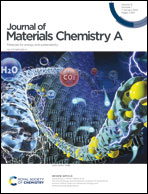Impedance modelling of all-solid-state thin film batteries: influence of the reaction kinetics
Abstract
Understanding the effect of material properties on the interface impedance is crucial for high energy all-solid-state thin film lithium-ion battery design. Nevertheless, reaction kinetics determined by the free enthalpy difference at the interface and the vacancy effect in solids are always ignored or simplified when simulating battery impedance. In this work, we obtain the numerical impedance results by using an advanced electrochemical model (modified Planck–Nernst–Poisson model coupled with the new Frumkin–Butler–Volmer equation), whereby the mentioned issues are taken into account. More importantly, we derive a comprehensive equivalent circuit model from the electrochemical model, where all circuit elements are quantified from material properties. The results show that the high-frequency semicircle in the impedance spectrum is due to the bulk impedance and is associated with ion migration. Moreover, the plots at low and medium frequencies are assigned to the charge transfer resistance and the space charge layer capacitance. The results show that batteries with a higher free enthalpy difference lead to a significant decrease of the charge transfer resistance, but increase the electrostatic potential drop. Lithium-ion diffusivity has no impact on the interface impedance, but can dominantly reduce the bulk resistance. The simulation results were verified at the end against experimental impedance spectra.



 Please wait while we load your content...
Please wait while we load your content...